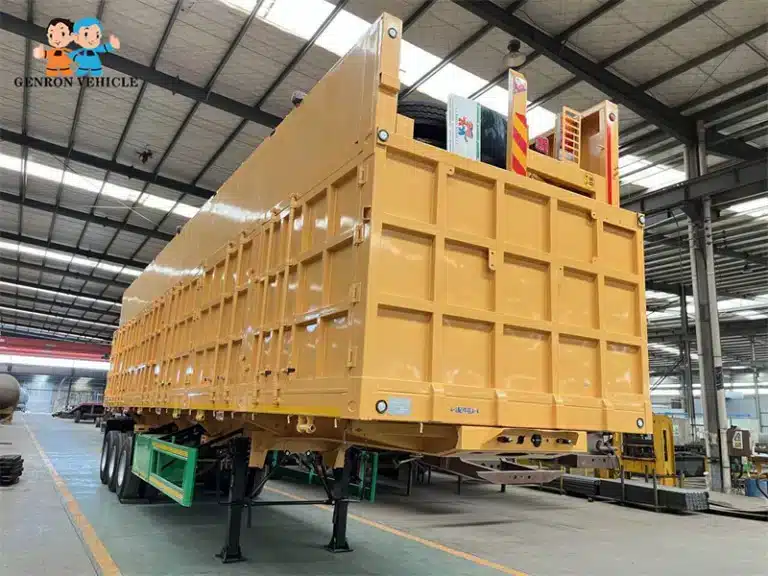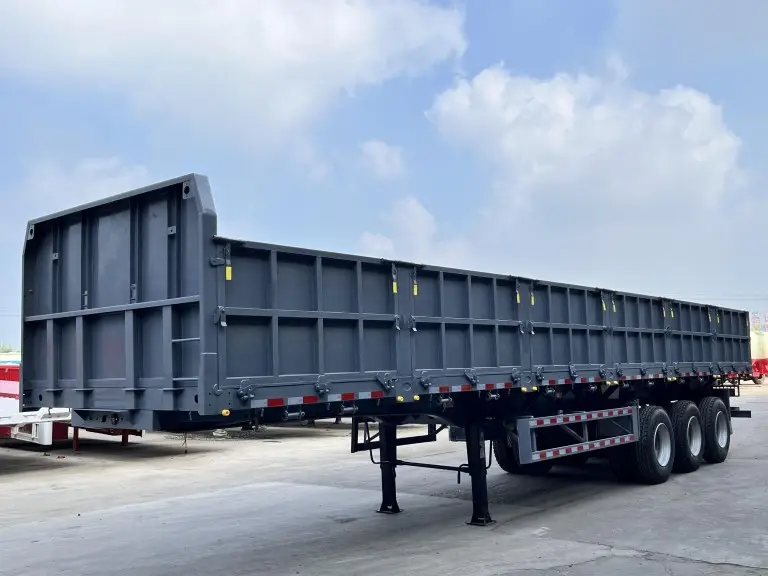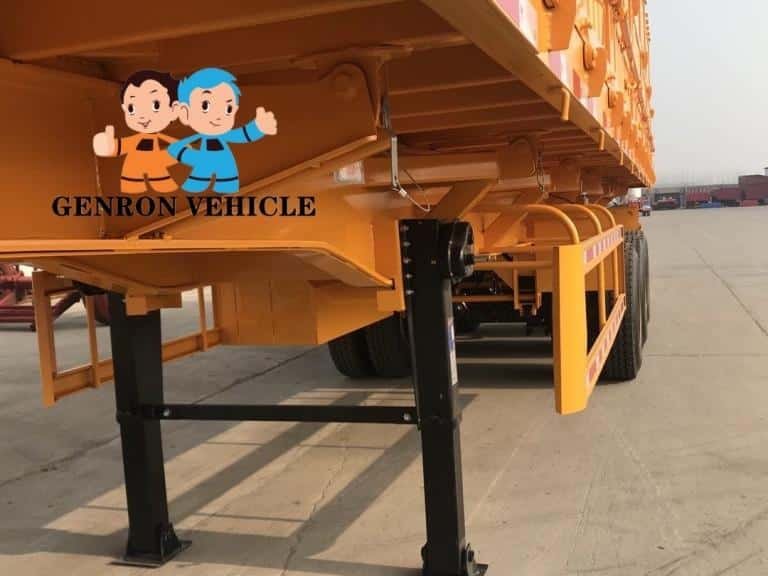Genron focus on creating top-notch semi-trailers, like our side tipper model. Tipper trailers are key in many sectors, making bulk material transport and unloading efficient.
Deciding between a side tipper and an end tipper greatly affects your operation’s efficiency and functionality. Both are used in construction, mining, and waste management. Yet, they serve different purposes and have unique features.
We’ll delve into the main differences between these trailers. We’ll look at their design, unloading methods, safety features, and industry uses. This will help you make a well-informed choice for your transport needs.
Table of Contents
Understanding Tipper Trailers
Tipper trailers are vital in sectors like construction and mining. They’re essential for efficient material transport. These trailers play a crucial role in project success.
Tipper trailers, also known as dump trailers, have an open-top body and a hydraulic system. They can tip and unload their contents. Loading materials, transporting them, and then using the hydraulic system to unload are their main functions. This makes them essential for handling heavy or bulky materials.
Choosing the right tipper trailer is key for efficiency and safety. The choice between side tipper and end tipper depends on several factors. These include job site conditions, material type, and space constraints. By picking the right tipper, businesses can boost efficiency, cut costs, and improve project results. At Genron International Trade, we help clients find the best tipper for their needs.
What is the difference between side tipper and end tipper?
Knowing the differences between side and end tippers is crucial for making the right choice. Both types are designed for efficient cargo unloading. However, they differ in design and functionality.
Design and Mechanical Differences
The main difference lies in their unloading mechanisms. Side tipper trailers use a lateral discharge system. They have hydraulic cylinders on one side to lift the opposite side of the trailer bed. This allows materials to flow out along the trailer’s length. End tippers, on the other hand, have a rear-discharge system. They use front-mounted hydraulic cylinders to elevate the front of the trailer, causing materials to slide out through the rear tailgate.
| Trailer Type | Unloading Mechanism | Hydraulic System |
| Side Tipper | Lateral discharge | Hydraulic cylinders on one side |
| End Tipper | Rear discharge | Front-mounted hydraulic cylinders |
Unloading Mechanism Comparison
The unloading mechanisms of side and end tippers are their most notable difference. Side tippers can discharge materials along their entire length at once. This makes unloading faster for certain materials. End tippers, however, require materials to travel the full length of the bed. This might take longer but allows for more precise material placement.
Understanding these differences helps users choose the best trailer for their needs. This enhances efficiency and reduces costs.
Side Tipper Trailers: Features and Functionality
At Genron International Trade, we specialize in manufacturing side tipper trailers for diverse industrial needs. Our trailers are designed for efficient and safe unloading, making them crucial for various industries.
Design and Construction
Our side tipper trailers are built with a robust design to handle heavy loads and harsh environments. The flat floor under the round tanker lowers the center of gravity, enhancing safety and durability. Our side dump semi-trailers have a loading capacity of 50 to 150 tons, fitting a wide range of applications.
Hydraulic System and Unloading Process
The hydraulic system of our side tipper trailers ensures smooth and efficient unloading. The controlled side discharge minimizes the risk of material avalanches, especially with sticky materials. This feature boosts the safety and efficiency of unloading.
Stability and Safety Features
Safety is a top priority in our side tipper trailers. They come with multiple safety features for stable operation during transport and unloading. These include sophisticated weight distribution systems, advanced stability control, and safety interlocks to prevent tipping accidents. Reinforced landing gear and stabilizing outriggers provide additional support during unloading.
Continue to check out What is a Side Dump Trailer for more insights
End Tipper Trailers: Features and Functionality
In heavy transportation, end dump trailers are essential for safe and efficient unloading. They are designed to handle various tasks across different industries.
Design and Construction
End tipper trailers are built to withstand heavy-duty applications. Their rational design, including compactness and well-connected welding seams, impacts safety and longevity. When inspecting an end tipper trailer, check the structure carefully for compactness and well-connected welding seams.
Hydraulic System and Unloading Process
The hydraulic system of an end tipper trailer is key to its unloading process. Modern end tippers have advanced hydraulic systems for smooth unloading. This system, combined with a robust tailgate locking mechanism, ensures secure transport and controlled release during unloading.
Stability and Safety Features
End tipper trailers have comprehensive safety features for stable operation during vertical lifting and rear discharge. Key features include tilt sensors, rear stabilizer legs, and hydraulic pressure relief valves to prevent system overload. Visibility during unloading is also crucial, with designs that maintain clear sightlines for operators.
Comparative Advantages and Limitations
Tipper trailers, whether side tippers or end tippers, have distinct advantages for different applications. Understanding these differences is crucial for selecting the right trailer for specific needs.
When Side Tippers Outperform End Tippers
Side tipper trailers excel in certain scenarios. They shine in spreading materials over wide areas, like in road maintenance or large landscaping projects. Their side tipping mechanism allows for controlled material distribution, perfect for broad coverage needs.
They also excel in tight spaces, unloading materials without needing to back up. This flexibility is invaluable in confined areas.
When End Tippers Are the Better Choice
End tippers, or rear tippers, outperform in tasks needing precise material placement. This includes filling foundation excavations or specific dumping zones. They offer straightforward operation, which many drivers prefer, potentially cutting down on training needs.
End tippers also dump materials at steeper angles, ideal for discharging sticky materials. Their rear discharge ensures precise material placement, crucial for specific tasks.
Industry Applications and Use Cases
The choice between side and end tipper trailers impacts various industries. These include construction, mining, and agriculture. Tipper trailers are vital for their efficiency in material transport and unloading.
Construction and Mining Applications: In construction and mining, tipper trailer efficiency affects project timelines and costs. Side tippers are advantageous in tight spaces, reducing unloading time and saving fuel. This boosts productivity significantly. For example, in mining, side tippers quickly unload materials in confined areas, enhancing efficiency.
Agricultural and Waste Management Uses: In agriculture and waste management, tipper trailer versatility is key. End tippers are preferred for waste management due to their simple unloading process. However, side tippers are better in agriculture for their maneuverability. The right tipper trailer choice can lower costs and improve transportation logistics.
Transportation and Logistics Considerations: Transportation and logistics involve evaluating the entire cycle time. Side tippers can reduce unloading time in some cases, while end tippers are better for wider areas. Fleet managers must consider route characteristics and material types to select the best tipper semi trailer. This ensures optimal efficiency and fuel savings.
Maintenance, Durability, and Cost Considerations
Maintenance, durability, and cost are crucial when choosing between side and end tipper trailers. At Genron International Trade, we understand the importance of these factors in making an informed decision.
Maintenance Requirements Comparison
Side tipper trailers require more complex maintenance due to their hydraulic systems and reinforced sides. End tippers, with their simpler design, may need less maintenance. Regular inspections are essential for optimal performance.
- Side tippers need more frequent checks on their hydraulic systems.
- End tippers may require less maintenance but need more space to operate effectively.
Durability and Lifespan Factors
The durability of a tipper trailer depends on its construction materials and quality. We use premium materials to ensure our trailers endure rigorous use. Proper maintenance and regular servicing can extend the lifespan of both side and end tippers.
Initial Investment and Long-term Value
Side tippers may have a higher initial cost, but their efficiency can lead to long-term savings. End tippers, with a lower upfront cost, might incur higher operational expenses in certain applications. We offer customization options to optimize your investment.
Our tipper semi trailers are designed to provide long-term value. Factors like fuel efficiency and resale value are crucial. By choosing the right tipper for your needs, you can achieve significant operational savings.
Conclusion: Choosing the Right Tipper for Your Needs
Understanding the differences between side and end tippers is key to making the right choice for your operational needs. At Genron International Trade, we offer both side tipper and end tipper trailer options with customization capabilities. When selecting a tipper trailer, consider factors like unloading sites, material types, and space constraints. Our experienced team can help you develop a tipper specification that optimizes performance and cost-effectiveness. Investing in a quality tipper semi or semi trailer will yield long-term benefits.
FAQ
How do side tipper trailers differ from end tipper trailers in terms of unloading mechanism?
Side tipper trailers unload their contents by tilting to one side. End tipper trailers, also known as rear tipper trailers, unload by tilting their bed at the rear. This fundamental difference affects their application and suitability for various tasks.
What are the advantages of using a side tipper trailer over an end tipper trailer?
Side tipper trailers offer better stability during unloading, especially on uneven terrain. They can be more efficient for certain types of cargo, such as loose materials that need to be spread out. They are particularly useful in construction and mining applications where precise unloading is required.
Are end tipper trailers more cost-effective than side tipper trailers?
The cost-effectiveness of end tipper trailers compared to side tipper trailers depends on several factors. These include the initial purchase price, maintenance costs, and the specific requirements of the job. Generally, end tippers are simpler in design and may have lower initial costs. However, their suitability for certain tasks can affect their overall cost-effectiveness.
Can tipper trailers be used for agricultural purposes?
Yes, both side tipper and end tipper trailers are used in agricultural settings. They are used for tasks such as transporting and unloading grain, fertilizers, or other materials. The choice between them depends on the specific needs of the farm, including the type of cargo and the terrain.
What safety features should be considered when operating tipper trailers?
Safety features to consider include the stability of the trailer during unloading. Also, the presence of safety valves in the hydraulic system and the condition of the trailer’s tires and brakes are important. Regular maintenance is also crucial to ensure safe operation.
How do hydraulic systems in tipper trailers work?
The hydraulic system in tipper trailers is responsible for lifting and tilting the trailer bed. It consists of hydraulic cylinders, pumps, and valves that work together to provide the necessary force for unloading. The system’s design and capacity can vary depending on the trailer’s size and type.
What are the key considerations for choosing between a side tipper and an end tipper trailer?
Key considerations include the type of cargo, the terrain on which the trailer will be used, and the required unloading precision. Also, the available space for maneuvering is important. Understanding these factors helps in selecting the most appropriate tipper trailer for specific needs.





